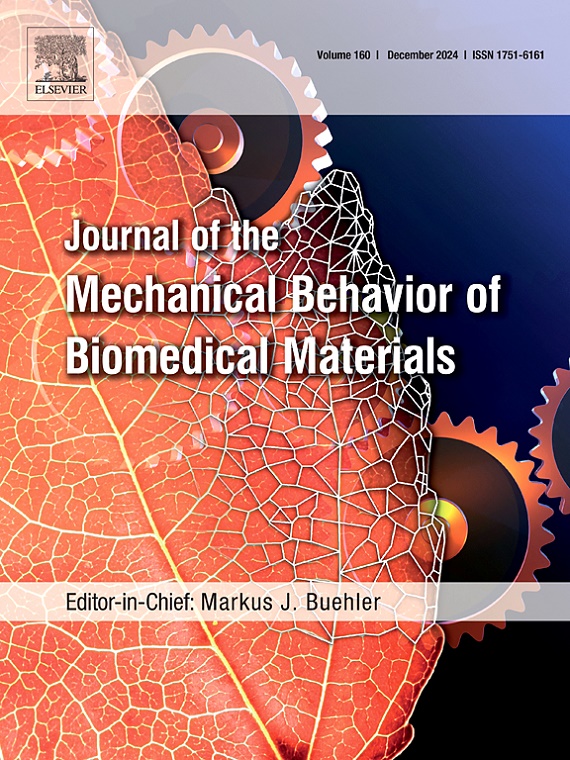A shellfish-inspired bionic microstructure design for biological implants: Enhancing protection of antibacterial silver-loaded coatings and promoting osseointegration
IF 3.3
2区 医学
Q2 ENGINEERING, BIOMEDICAL
Journal of the Mechanical Behavior of Biomedical Materials
Pub Date : 2025-02-26
DOI:10.1016/j.jmbbm.2025.106963
引用次数: 0
Abstract
Implants incorporating multi-level micro-nano structures and antibacterial coatings offer a promising approach to overcoming the shortcomings of titanium and its alloys in stimulating bone growth and preventing bacterial infections. Silver ions have been identified as promising antibacterial agents. However, silver-loaded surface coatings are susceptible to damage from direct friction, and excessive release of silver ions can lead to cytotoxicity, thereby limiting their practical application. Inspired by the wear-resistant surface structure of natural shellfish, this study developed a biomimetic micro/nano multi-level structure on the titanium alloy (TC4) surfaces. The structure incorporated a biomimetic microgroove structure (BMS) with alkaline heat treatment (AH) of sodium titanate and chitosan/silver (CS/Ag) micro-nanostructured coatings (BMS/AH/CS/Ag). The microstructural armor effectively reduced external mechanical friction, safeguarding the coatings from damage. Compared to the unstructured sample, the biomimetic micro-groove armor group with a large micro-groove angle (θ) exhibited significantly reduced wear volume and only a marginal decrease of 1.86% in inhibition against Staphylococcus aureus (S. aureus) post-wear, highlighting the protective effect of this microstructure on the coating. The outstanding improvement was primarily attributed to the increased micro-groove angle, which enhanced the stability of the microstructure and effectively mitigated the friction. Additionally, the biomimetic micro-nano multi-level structure and coating have shown a significant ability to improve the bioactivity for the implant, promoting the adhesion, proliferation, collagen secretion, and extracellular matrix mineralization of human mesenchymal stem cells (hMSCs), which suggests the potential for enhanced osteogenic differentiation and indicates that this method can effectively improve the clinical performance of the implant.

以贝类为灵感的生物植入物仿生微观结构设计:增强抗菌银负载涂层的保护并促进骨整合
植入物采用多层微纳米结构和抗菌涂层,为克服钛及其合金在刺激骨骼生长和防止细菌感染方面的缺点提供了一种很有前途的方法。银离子是一种很有前途的抗菌剂。然而,负载银的表面涂层容易受到直接摩擦的损伤,并且银离子的过度释放会导致细胞毒性,从而限制了它们的实际应用。本研究受天然贝类耐磨表面结构的启发,在钛合金(TC4)表面开发了仿生微纳多层结构。该结构采用钛酸钠碱性热处理后的仿生微槽结构(BMS)和壳聚糖/银(CS/Ag)微纳米结构涂层(BMS/AH/CS/Ag)。微结构装甲有效地减少了外部机械摩擦,保护涂层免受破坏。与非结构化样品相比,具有较大微槽角(θ)的仿生微槽装甲组磨损体积明显减小,对金黄色葡萄球菌(S. aureus)的抑制作用仅下降1.86%,凸显了该微观结构对涂层的保护作用。这种显著的改善主要是由于微槽角的增加,提高了组织的稳定性,有效地减轻了摩擦。此外,仿生微纳多层结构和涂层显著提高了种植体的生物活性,促进了人间充质干细胞(hMSCs)的粘附、增殖、胶原分泌和细胞外基质矿化,这表明该方法具有增强成骨分化的潜力,可以有效提高种植体的临床性能。
本文章由计算机程序翻译,如有差异,请以英文原文为准。
求助全文
约1分钟内获得全文
求助全文
来源期刊

Journal of the Mechanical Behavior of Biomedical Materials
工程技术-材料科学:生物材料
CiteScore
7.20
自引率
7.70%
发文量
505
审稿时长
46 days
期刊介绍:
The Journal of the Mechanical Behavior of Biomedical Materials is concerned with the mechanical deformation, damage and failure under applied forces, of biological material (at the tissue, cellular and molecular levels) and of biomaterials, i.e. those materials which are designed to mimic or replace biological materials.
The primary focus of the journal is the synthesis of materials science, biology, and medical and dental science. Reports of fundamental scientific investigations are welcome, as are articles concerned with the practical application of materials in medical devices. Both experimental and theoretical work is of interest; theoretical papers will normally include comparison of predictions with experimental data, though we recognize that this may not always be appropriate. The journal also publishes technical notes concerned with emerging experimental or theoretical techniques, letters to the editor and, by invitation, review articles and papers describing existing techniques for the benefit of an interdisciplinary readership.
 求助内容:
求助内容: 应助结果提醒方式:
应助结果提醒方式:


